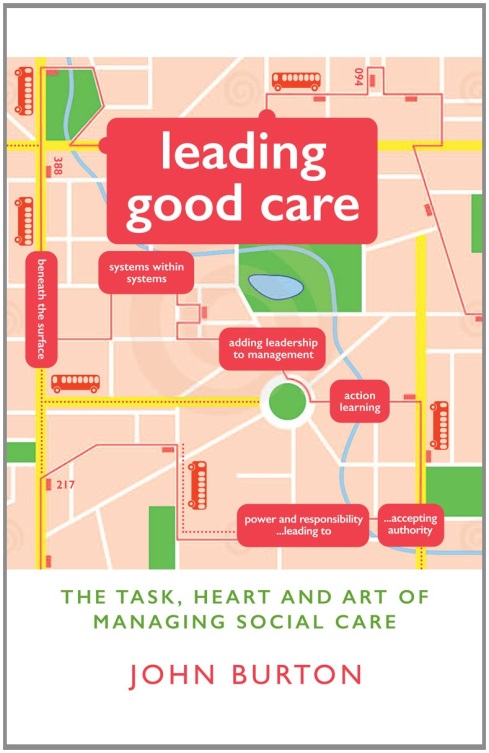 John Burton has worked in social care since 1965 as a practitioner at all levels. His book, Leading Good Care, is just out from Jessica Kingsley Publishers. (1,342 words)
John Burton has worked in social care since 1965 as a practitioner at all levels. His book, Leading Good Care, is just out from Jessica Kingsley Publishers. (1,342 words)
In Leading Good Care, I set out and recommend a positive and hopeful vision of social care. My subtitle—the task, heart and art of managing social care—is both realistic and idealistic. The task requires serious, disciplined, hands-on, and hard work. The heart signifies that this work is emotional and personal, and that care is a human relationship. And the art of managing care engages your skills, your imagination, your culture and creativity.
In the last couple of weeks I’ve been at two meetings where very senior managers were pleading that they were powerless to change something they knew should be changed. So, major care providers that should be paying a living wage say they would like to but can’t, and a national training and development organization can’t pay the modest public transport expenses of the expert volunteers it wants to recruit to help it run a programme for managers. Yet these are the organizations that are charged with leading change in social care.
It seems that when you reach the dizzy heights of Chief Executive Officer or head of Human Resources, raking in loads of dosh and all the expenses you could possibly wish for, you can wash your hands of taking a stand on life-changing issues for the social care workforce.
Having spent 50 years immersed in social care—sometimes waving, sometimes drowning and sometimes swimming strongly (usually against the tide)—this is a familiar experience for me. If you want to change something important, you have to just do it. At the same time you have to understand that the very people and organizations that profess they want the changes you are making will be the ones who are keeping things just as they are. They don’t mean to, but their record for not rocking the boat means that inaction is their default position.
 In the 1980s several seminal reports, including Home Life (1984) and A Positive Choice (1988), called for an end to residents having to share bedrooms in care homes. I was head of a 120-place local authority home at the time and refused to admit any more residents to our eight 4-bedded rooms. I was threatened by my managers and told that we couldn’t do anything about multi-occupied rooms until the council decided to. But I was working to a higher authority than the council . . . no, not to God! nor to the government of the time, but to my professional authority, principles and values which sprang from the core task, the good care of the residents and potential residents. We changed a rotten institution into a really good place by sticking our necks out. Senior management and the council never dared to carry through their threats partly because we had created a professional network and working partnerships with other homes, social work teams, doctors and district nurses, the home help teams, and with people and organizations outside the council.
In the 1980s several seminal reports, including Home Life (1984) and A Positive Choice (1988), called for an end to residents having to share bedrooms in care homes. I was head of a 120-place local authority home at the time and refused to admit any more residents to our eight 4-bedded rooms. I was threatened by my managers and told that we couldn’t do anything about multi-occupied rooms until the council decided to. But I was working to a higher authority than the council . . . no, not to God! nor to the government of the time, but to my professional authority, principles and values which sprang from the core task, the good care of the residents and potential residents. We changed a rotten institution into a really good place by sticking our necks out. Senior management and the council never dared to carry through their threats partly because we had created a professional network and working partnerships with other homes, social work teams, doctors and district nurses, the home help teams, and with people and organizations outside the council.
As well as being the decade of Home Life and A Positive Choice (showing the way to create good care), the 1980s and early 90s saw successive scandals in children’s homes and adult care homes (such as ‘Pin Down’ and Nye Bevan Lodge). Government reacted not by understanding and supporting how good care is created and led, but by wave after wave of legislation to ‘stamp out’ bad practice. The new rules were designed for the minority of poor care services, but were of course applied across the board to the good services as well as the bad.
Nationwide regulation, standards and inspection were introduced in the early 2000s alongside new institutions for training and ‘excellence’ (whatever that is) which proceeded to impose more top-down, finger-wagging, holier-than-thou, do-as-you’re-told, ever-changing instructions for ‘delivering’ care. Our current social care system is completely dominated by meeting their requirements rather than meeting the needs of the people for whom social care exists (the core task). Based on the premise that all social care services are inherently neglectful and abusive, and therefore must be policed, the regulator exists to protect government, to absolve them of blame for poor care (even when it is obvious to everyone that services have been starved of resources), and to project blame onto those who provide the care. When the regulator fails to protect government (as in Mid Staffs, Winterbourne View and many other recent examples), government turns on the regulator and makes them impose further instructions and tests that result in even more time being spent by providers satisfying the regulator rather than giving care.
The public do need their social care services inspected to check that they are good enough, but social care is essentially a local service whoever provides it. Inspectors should work in local teams that are responsible, accountable and accessible to the public. Currently inspectors don’t even sign their inspection reports which all have to go through a ‘quality assurance’ process before they are released, often many weeks after the inspection, to the public. Inspectors themselves are given little professional authority; they work to a book of rules and procedures, with their managers breathing down their necks and passing on the survival anxiety emanating from the top of the organization.
To many in social care, it now feels as if there is no room to deviate from the rules; you must comply. But in reality there are thousands of managers and care staff who have learned how to produce the right answers for the regulator, and yet, as wasteful and time consuming as that is, they still manage to give good care through relationships that are based on real feelings, on mutual respect and understanding, on their own professional standards and responses.
I know of and work with good care services that have learned how to give the right answers to satisfy the regulator, and yet they make time for their core task. Indeed, they have more time for their core task because they’re not perpetually preoccupied with compliance. But how much more time would they have if they didn’t have to feed the hungry regulatory machine to prevent it from devouring them?
I know of good care services that struggle because they don’t have the resources to spare to feed the regulator and they try to stick to their core task of good care. And I know of some not so good services that, under pressure to obtain the essential ‘good’ or even ‘outstanding’ rating feel compelled to buy in consultants who will manufacture for them the ‘evidence’ the regulator demands. (These consultants are often ex-inspectors.)
The only people who can improve social care are the registered managers and their care teams. From day to day and week to week they ‘just do it’. They have to take difficult decisions and face very challenging situations for which there is no ‘right answer’ and no book of instructions, but generally care is good. The people at the top (including regulators and senior managers) have no power to improve care but they do control the resources and the policy direction that can enable and empower the registered managers and their care teams to create and maintain good care. Instead of getting in their way, issuing instructions, and diverting resources that should be put into the core task, they should be facilitating, encouraging and supporting care services to ‘just do it’. Equally they should stand shoulder to shoulder with those who do it, and when they see something that is clearly obstructive or disempowering, they should have the professional authority and courage to change it. So, for good care’s sake, just do it.
John Burton has worked in social care since 1965 as a practitioner at all levels, and is now an Independent Social Care Consultant.